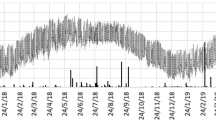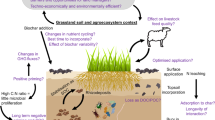Abstract
As global climate change (GCC) becomes an increasing societal concern, scientists are assessing soils’ capacity to sequester atmospheric CO2 to off-set anthropogenic emissions. Therefore, this study was conducted to determine C sequestration potential in golf turfgrass systems in Central Ohio, USA, and to determine the effect of management practices on the net soil C sink capacity. Ohio farmland soils converted to golf course turfgrasses sequestered C at mean rates of 3.55 ± 0.08 Mg/ha/yr in fairways and 2.64 ± 0.06 Mg/ha/yr in rough areas. Soils in both fairway and rough areas sequestered C to 15 cm depth. However, hidden C costs of golf course development and management were also significant and major C emissions were attributed to diesel fuel combustion (6,557 kg Ce(Carbon Equivalents)/yr), unleaded fuel combustion (3,618 kg Ce/yr), N fertilizer use (1,498 kg Ce/yr), fungicide application (1,377 kg Ce/yr) and irrigation (626 kg Ce/yr), for an overall C emission of 14.15 Mg Ce per course per year (0.30 Mg C/ha/yr). Analysis of sequestration and emissions data showed that a newly constructed golf course has a technical C sequestration capacity of 2,224 Mg C over a 91.4 year period or the equivalent of 0.44 Mg C/ha/yr. However, the large C emissions generated by maintenance practices render courses from sinks to sources within 30 years. To maximize the potential environmental benefits of turfgrass systems while increasing the economic efficiency of each site, management practices with low C-intensity should be utilized.



Similar content being viewed by others
References
Bandaranayake W, Qian YL, Parton WJ, Ojima DS, Follett RF (2003) Estimation of soil organic carbon changes in turfgrass systems using the CENTURY model. Agron J 95:558–563
Beckage B, Osborne B, Gavin DG, Pucko C, Siccama T, Perkins T (2008) A rapid upward shift of a forest ecotone during 40 years of warming in the Green Mountains of Vermont. Proc Natl Acad Sci US Am 105:4197–4202
Blake GR, Hartage KH (1986) Bulk density. In: Klute A (ed) Methods of soil analysis part 1: Physical and mineralogical methods, agronomy monograph No. 9, 2nd edn. ASA and SSSA, Madison, pp 363–382
Burke IC, Yonker CM, Parton WJ, Cole CV, Flach K, Schimel DS (1989) Texture, climate, and cultivation effects on soil organic matter content in U.S. grassland soils. Soil Sci Soc Am J 6:800–805
Burke IC, Lauenroth WK, Coffin DP (1995) Soil organic matter recovery in semiarid grasslands: implications for the conservation reserve program. Ecol Appl 5:793–801
Buyanovsky GA, Wagner GH (1998) Carbon cycling in cultivated land and its global significance. Glob Chang Biol 4:131–141
Cockerham ST, Gibeault VA (1985) The size, scope, and importance of the turfgrass industry. In: Gibeault VA, Cockerham ST (eds) Turfgrass water conservation. University of California, Oakland, pp 7–12
Conant RT, Paustian K, Elliott ET (2001) Grassland management and conversion into grassland: effects on soil carbon. Ecol Appl 11:343–355
Davidson EA, Ackerman IL (1993) Changes in soil carbon inventories following cultivation of previously untilled soils. Biogeochemistry 20:161–193
Falk JH (1976) Energetics of a suburban lawn ecosystem. Ecology 57:141–150
Follett RF, Kimble JM, Lal R (2001a) The potential of U.S. grazing lands to sequester carbon and mitigate the Greenhouse Effect. CRC/Lewis, Boca Raton
Follett R, Pruessner EG, Samson-Liebig SE, Kimble JM, Waltman SW (2001b) Carbon sequestration under the conservation reserve program in the historic grassland soils of the United States of America. In: Lal R (ed) Soil carbon sequestration and the greenhouse effect. SSSA, Madison, pp 27–40
Gebhart DL, Johnson HB, Mayeux HS, Polley HW (1994) The CRP increases soil organic carbon. J Soil Water Conserv 49:488–492
Golubiewski NE (2006) Urbanization increases grassland carbon pools: effects of landscaping in Colorado’s front range. Ecol Appl 16:555–571
Higby JR, Bell PF (1999) Low soil nitrate levels from golf course fairways related to organic matter sink for nitrogen. Commun Soil Sci Plant Anal 30:573–588
Huh KY, Deurer M, Sivakumaran S, McAuliffe K, Bolan NS (2008) Carbon sequestration in urban landscapes: the example of a turfgrass system in New Zealand. Aust J Soil Res 46:610–616
IPCC (2007) Climate change: summary for policy makers. Cambridge University Press, Cambridge
Jo HK, McPherson GE (1995) Significant C storeage in lawns – Greenspace planning and management strategies were explores to minimize carbon release and maximize carbon uptake. J Environ Manage 45:109–133
Karhu K, Fritze H, Hamalainen K et al (2010) Temperature sensitivity of soil carbon fractions in boreal forest soil. Ecology 91:370–376
Lal R (2004a) Soil carbon sequestration to mitigate climate change. Geoderma 123:1–22
Lal R (2004b) Carbon emissions from farm operations. Environ Int 30:981–990
Lal R, Bruce JP (1999) The potential of world cropland soils to sequester C and mitigate the greenhouse effect. Environ Sci Policy 2:177–185
Lal R, Kimble JM, Stewart BA (2000) Global climate change and cold regions ecosystems. CRC/Lewis, Boca Raton
Mensah F, Schoenau JJ, Malhi SS (2003) Soil carbon changes in cultivated and excavated land converted to grasses in east-central Saskatchewan. Biogeochemistry 63:85–92
Metzger M, Bunce R, Leemans R, Viner D (2008) Projected environmental shifts under climate change: European trends and regional impacts. Environ Conserv 35:64–75
Ozenda P, Borel JL (1990) Possible responses of mountain vegetation to a global climatic change: the case of the Western Alps. In: Boer MM, deGroot RS (eds) Landscape-ecological impact of climate change. IOS Press, Amsterdam, pp 221–249
Pendall R (1999) Do land-use controls cause sprawl? Environ Plann B Plann Des 26:555–571
Peterjohn WT, Melillo JM, Bowles FP, Steudler PA (1993) Soil warming and trace gas fluxes: Experimental design and preliminary flux results. Oecologia 93:18–24
Pira E (1997) A guide to golf course irrigation system design and drainage. Ann Arbor Press, Chelsea
Potter KN, Torbert HA, Johnson HB, Tischler CR (1999) Carbon storage after long-term grass establishment on degraded soils. Soil Sci 164:718–725
Pouyat RV, Yesilonis ID, Golubiewski NE (2009a) A comparison of soil organic carbon stocks between residential turf grass and native soil. Urban Ecosystems 12:45–62
Pouyat RV, Yesilonis ID, Nowak DJ (2009b) Carbon storeage by urban soils in the United States. J Environ Qual 35:1566–1575
Qian Y, Follett RF (2002) Assessing soil carbon sequestration in trufgrass systems using long-term soil testing data. Agron J 94:930–935
Raich JW, Schlesinger WH (1992) The global carbon dioxide flux in soil respiration and its relationship to vegetation and climate. Tellus 44B:81–99
Sachs PD, Luff RT (2002) Ecological golf course management. Ann Arbor Press, Chelsea
Smith J (2009) What does golf want to stand for? Golf Course Architecture. http://webcache.googleusercontent.com/search?q=cache:yT-GylE7YJ0J:www.golfcoursearchitecture.net/Article/What-does-golf-want-to-stand-for/1499/Default.aspx+smith+2009+%22what+does+golf+want+to+stand+for%22&cd=1&hl=en&ct=clnk&gl=us&source=www.google.com. Accessed 21 Dec 2010
Schlentner RE, Van Cleve K (1985) Relationships between CO2 evolution from soil, substrate temperature, and substrate moisture in four mature forest types in interior. Can J For Res 15:97–106
Schleser GH (1982) The response of CO2 evolution from soils to global temperature changes. Z Nat Forsch, C J Biosci 37:287–291
Whiffen HH (1991) Energy use in irrigation. Energy Efficiency & Environmental News. Florida Energy Extension Service. Gainesville, FL
Wiant HV (1967) Influence of moisture content on “soil respiration”. Soc Am Foresters 65:902–903
Wilson WS (1991) Advances in soil organic matter research: the impact of agriculture and the environment. Royal Society of Chemistry, Cambridge
WMO (2009) WMO Greenhouse gas bulletin. http://www.wmo.int/pages/prog/arep/gaw/ghg/documents/ghg-bulletin2008_en.pdf. Accessed 3 Jan 2011
Acknowledgments
We thank all of the golf course superintendents for allowing us the time and use of their land for soil sampling. Special consideration goes to John Hoyle, superintendent of Oakhurst Country Club, for providing us with long term fertilization and pesticide data, as well as fuel data and other information making this research possible.
Additional gratitude goes to Klaus Lorenz and Basant Rimal who aided in C analysis as well as Bert Bishop for his help with the statistical analysis.
This work was funded by both the Environmental Science Graduate Program and the Introductory Biology Program at The Ohio State University.
Author information
Authors and Affiliations
Corresponding author
Rights and permissions
About this article
Cite this article
Selhorst, A.L., Lal, R. Carbon budgeting in golf course soils of Central Ohio. Urban Ecosyst 14, 771–781 (2011). https://doi.org/10.1007/s11252-011-0168-5
Published:
Issue Date:
DOI: https://doi.org/10.1007/s11252-011-0168-5




